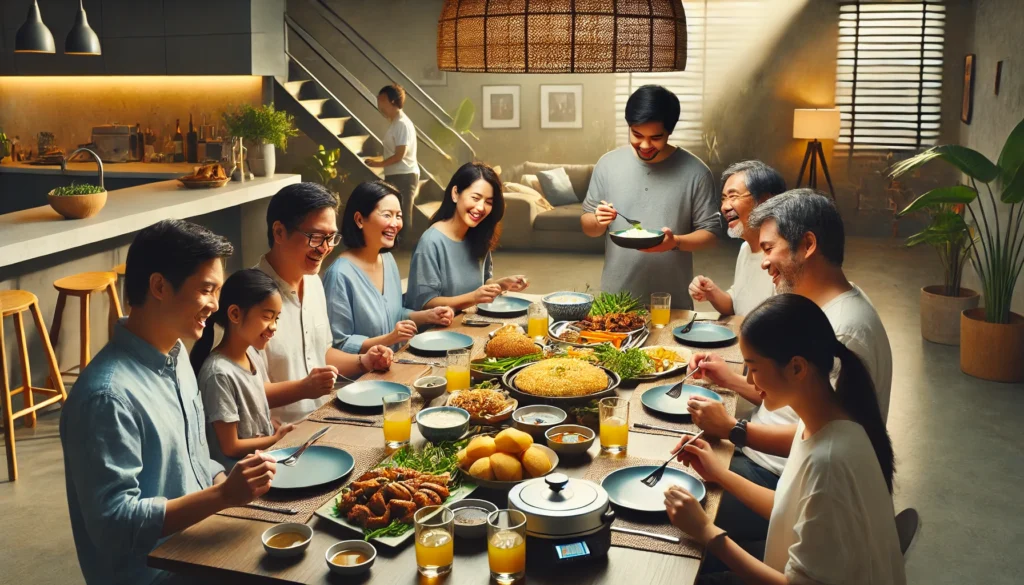Food plays a central role in Filipino culture, serving as a unifying force that brings people together and strengthens social bonds. In the Philippines, social gatherings are incomplete without an array of delicious dishes that reflect the country’s rich culinary heritage. This blog explores the significance of food in Filipino social gatherings, examining its historical roots, cultural importance, and the various ways it influences social interactions. From family reunions to religious festivals, food remains an integral part of Filipino social life, embodying the warmth, hospitality, and communal spirit that characterize the nation’s culture. By understanding the role of food in Filipino social gatherings, we gain valuable insights into the country’s traditions, values, and the deep-seated connections between cuisine and community.
Historical Context of Filipino Cuisine
Pre-colonial Influences
The history of Filipino cuisine dates back thousands of years, with indigenous ingredients and cooking methods forming the foundation of the country’s culinary traditions. Before the arrival of foreign influences, early Filipinos relied on locally available resources such as rice, root crops, fruits, and seafood. The abundance of tropical ingredients and the archipelagic nature of the Philippines contributed to the development of diverse regional cuisines. These early culinary practices emphasized the use of fresh, seasonal ingredients and simple cooking techniques that allowed the natural flavors of the food to shine. Communal eating was already a significant aspect of social life during this period, with families and communities gathering to share meals and celebrate important events.
Colonial Influences on Filipino Cuisine
The arrival of Spanish colonizers in the 16th century marked a significant turning point in the evolution of Filipino cuisine. Over three centuries of Spanish rule introduced new ingredients, cooking methods, and dishes that became integral to Filipino culinary culture. The Spanish brought with them ingredients such as tomatoes, potatoes, and various spices, which were incorporated into existing recipes and led to the creation of new dishes. The influence of Spanish cuisine is evident in popular Filipino dishes such as adobo, lechon, and paella. Following Spanish colonization, the American period in the early 20th century further diversified Filipino cuisine, introducing fast food culture and American-style dishes that were adapted to local tastes. These colonial influences, combined with the country’s indigenous culinary traditions, resulted in the unique fusion cuisine that characterizes Filipino food today.
The Cultural Significance of Food in Filipino Society
Food as a Symbol of Hospitality
In Filipino culture, food is more than just sustenance; it is a powerful symbol of hospitality and generosity. The act of offering food to guests is deeply ingrained in Filipino social etiquette and is considered an essential expression of welcome and respect. When visitors arrive at a Filipino home, they are often greeted with the phrase “Kumain ka na ba?” (Have you eaten?), followed by an invitation to share a meal or snack. This practice reflects the belief that sharing food creates a bond between host and guest, fostering a sense of community and goodwill. The abundance and variety of food served during social gatherings are seen as a reflection of the host’s hospitality and desire to ensure the comfort and satisfaction of their guests. This emphasis on food as a means of welcoming and honoring others contributes to the warm and inclusive atmosphere that characterizes Filipino social gatherings.
Food as a Reflection of Filipino Values
The centrality of food in Filipino social gatherings is deeply rooted in the country’s cultural values and social norms. Filipino cuisine and eating practices reflect important cultural concepts such as “pakikisama” (camaraderie), “bayanihan” (communal unity), and “utang na loob” (debt of gratitude). The act of preparing and sharing food is seen as a way to strengthen social ties, express care for others, and fulfill social obligations. Large family gatherings and community events often revolve around the preparation and consumption of food, with members contributing dishes or participating in the cooking process. This communal approach to food preparation and consumption reinforces the Filipino value of collective effort and shared responsibility. Additionally, the practice of “pasalubong” (bringing gifts, often food, when returning from a trip) demonstrates the importance of food as a means of maintaining connections and expressing thoughtfulness in Filipino culture.
Types of Filipino Social Gatherings Centered Around Food
Family Celebrations
Family celebrations form the cornerstone of Filipino social life, and food plays a central role in these gatherings. Birthdays, weddings, baptisms, and graduations are marked by elaborate feasts that bring extended families together. These celebrations often feature traditional dishes that hold special significance for the occasion. For example, birthday celebrations typically include pancit (noodles), which symbolize long life, while weddings may feature whole roasted pig (lechon) as a symbol of abundance and prosperity. Family reunions, known as “balikbayan” gatherings, are particularly important events that showcase the role of food in maintaining family ties. These reunions often involve overseas Filipino workers returning home and are characterized by lavish spreads of traditional and modern Filipino dishes that evoke nostalgia and reinforce family bonds.
Religious and Cultural Festivals
Religious and cultural festivals in the Philippines are intrinsically linked to food, with specific dishes and culinary traditions associated with various celebrations. The Christmas season, known as “Pasko,” is one of the most important periods for food-centric gatherings in the Philippines. Noche Buena, the traditional Christmas Eve feast, features an array of special dishes such as ham, queso de bola (Edam cheese), and various desserts. Holy Week observances also involve unique food traditions, with many Filipinos abstaining from meat and preparing vegetarian or seafood dishes. Regional festivals, such as the Pahiyas Festival in Quezon and the Kadayawan Festival in Davao, showcase local agricultural products and culinary specialties, highlighting the diversity of Filipino cuisine and its connection to cultural identity. These festivals not only celebrate food but also serve as important occasions for communities to come together and strengthen social bonds through shared culinary experiences.
Popular Dishes Served at Filipino Social Gatherings
Main Courses
Filipino social gatherings are known for their impressive array of main courses that cater to diverse tastes and preferences. These dishes often reflect the country’s culinary heritage and the importance of communal eating. Here are some popular main courses commonly served at Filipino social gatherings:
| Dish | Description | Significance |
|---|---|---|
| Lechon | Whole roasted pig | Symbol of abundance and celebration |
| Adobo | Meat stewed in vinegar and soy sauce | National dish of the Philippines |
| Kare-kare | Oxtail stew with peanut sauce | Represents Filipino ingenuity in cooking |
| Pancit | Stir-fried noodles | Symbolizes long life and good health |
| Lumpia | Filipino-style spring rolls | Popular finger food at gatherings |
| Kaldereta | Meat stew with tomato sauce and liver spread | Hearty dish often served at fiestas |
These main courses are typically served family-style, encouraging sharing and interaction among guests. The variety of dishes ensures that there is something for everyone, reflecting the Filipino value of inclusivity and hospitality.
Desserts and Snacks
No Filipino social gathering is complete without an assortment of desserts and snacks, known as “merienda” or “pulutan” depending on the context. These sweet and savory treats are an essential part of Filipino food culture and often hold special significance in social settings. Here are some popular desserts and snacks served at Filipino gatherings:
| Dish | Description | Significance |
|---|---|---|
| Leche Flan | Caramel custard | A staple dessert at celebrations |
| Halo-halo | Mixed shaved ice dessert | Refreshing treat symbolizing diversity |
| Bibingka | Rice cake cooked in banana leaves | Traditional Christmas delicacy |
| Puto | Steamed rice cakes | Versatile snack often paired with savory dishes |
| Ensaymada | Brioche-like pastry | Popular for breakfast or merienda |
| Turon | Banana and jackfruit spring rolls | Sweet snack often sold as street food |
These desserts and snacks are often served throughout the gathering, encouraging continuous eating and socializing. The variety of flavors and textures in these treats reflects the Philippines’ diverse culinary influences and the importance of sweets in Filipino culture.
The Social Dynamics of Filipino Eating Practices
Communal Eating and “Kamayan”
Communal eating is a hallmark of Filipino social gatherings, reflecting the culture’s emphasis on sharing and togetherness. This practice is exemplified in “kamayan,” a traditional way of eating where food is served on banana leaves and eaten with bare hands. Kamayan dining has experienced a resurgence in recent years, both in the Philippines and in Filipino communities abroad, as a way to reconnect with cultural roots and enhance the social experience of eating. This style of eating encourages interaction and equality among diners, as everyone shares from the same spread. The absence of utensils and individual plates fosters a sense of intimacy and breaks down social barriers, allowing for a more relaxed and convivial atmosphere. Kamayan dining is particularly popular at large family gatherings, beach outings, and special celebrations, where it adds an element of tradition and nostalgia to the meal.
The Role of Elders and Hierarchy
Filipino social gatherings often reflect the culture’s respect for elders and adherence to social hierarchies, particularly in the context of food service and consumption. In traditional settings, elders are typically served first and are given the choicest portions of food as a sign of respect. This practice, known as “pagmamano,” extends to the dining table, where younger family members may seek the blessing of their elders before beginning to eat. The seating arrangement at formal gatherings often reflects social status, with honored guests and elders seated at the head of the table. While these practices may be less rigidly observed in more casual or modern settings, they continue to influence the dynamics of Filipino social gatherings. The role of elders in food-related activities, such as leading prayers before meals or being asked to taste and approve dishes, underscores the importance of age and experience in Filipino culture.
The Economic and Social Impact of Food in Filipino Gatherings
The “Fiesta” Economy
The central role of food in Filipino social gatherings has significant economic implications, giving rise to what is often referred to as the “fiesta economy.” This term describes the economic activities and expenditures associated with preparing for and hosting large-scale celebrations, particularly in rural areas. Fiestas, which are often tied to religious or cultural events, can involve entire communities and require substantial financial investments in food, decorations, and entertainment. The preparation for these events stimulates local economies by increasing demand for agricultural products, catering services, and related industries. According to a study conducted by the Philippine Institute for Development Studies in 2017, household expenditures on food for social gatherings and celebrations accounted for approximately 5% of total food expenditures in the country. This figure highlights the economic significance of food-centric social events in the Philippines and their impact on local markets and livelihoods.
| Aspect | Economic Impact |
|---|---|
| Agricultural Demand | Increased demand for local produce and livestock |
| Catering Services | Growth in the food service and events industry |
| Tourism | Attraction of domestic and international tourists to local festivals |
| Employment | Temporary job creation in food preparation and event organization |
| Local Businesses | Boost in sales for food vendors and suppliers |
Social Cohesion and Community Building
The emphasis on food in Filipino social gatherings plays a crucial role in fostering social cohesion and strengthening community ties. Large-scale celebrations like fiestas and community events centered around food provide opportunities for people to come together, share resources, and collaborate. These gatherings often involve collective food preparation, where community members contribute ingredients, labor, or cooking skills. This collaborative approach, known as “bayanihan,” reinforces social bonds and promotes a sense of shared identity and purpose. Food-centric events also serve as platforms for cultural preservation and transmission, as traditional recipes and cooking methods are passed down through generations. A survey conducted by the National Commission for Culture and the Arts in 2015 found that 87% of Filipinos considered food-related traditions to be an important aspect of their cultural identity. This statistic underscores the significance of food-centric gatherings in maintaining cultural continuity and social cohesion in Filipino communities.
Challenges and Adaptations in Modern Filipino Food Culture
Health Concerns and Dietary Shifts
As awareness of health issues grows and lifestyles change, Filipino food culture faces challenges in balancing tradition with health considerations. Many traditional Filipino dishes are high in fat, sugar, and salt, contributing to rising rates of obesity, diabetes, and cardiovascular diseases in the country. According to the Food and Nutrition Research Institute of the Department of Science and Technology, the prevalence of overweight and obesity among Filipino adults increased from 20.2% in 1993 to 31.1% in 2013. This trend has led to a growing emphasis on healthier cooking methods and ingredient substitutions in Filipino cuisine, even in the context of social gatherings. Some families and communities are adapting traditional recipes to include more vegetables, whole grains, and lean proteins, while reducing the use of processed ingredients and excessive fats. However, this shift presents a challenge in maintaining the authenticity and cultural significance of traditional dishes while addressing health concerns.
Globalization and the Changing Face of Filipino Cuisine
Globalization has had a significant impact on Filipino food culture, influencing both the types of dishes served at social gatherings and the ways in which these gatherings are conducted. The increased availability of international ingredients and exposure to global culinary trends has led to the incorporation of foreign elements into traditional Filipino dishes and the creation of fusion cuisines. This trend is particularly evident in urban areas and among younger generations. A study by the Philippine Statistics Authority in 2017 found that household expenditure on dining out and take-away food increased by 12.5% from 2012 to 2016, reflecting changing food consumption patterns and a growing preference for convenience foods. While these changes bring diversity and innovation to Filipino cuisine, they also raise questions about the preservation of culinary heritage and the role of traditional foods in social gatherings. Many Filipinos are seeking ways to balance the desire for modern, globalized dining experiences with the need to maintain cultural traditions and the social functions of food in gatherings.
Conclusion
Food remains an integral and dynamic aspect of Filipino social gatherings, serving as a powerful medium for cultural expression, social bonding, and community building. From traditional family celebrations to large-scale community fiestas, the preparation and sharing of food continue to play a central role in Filipino social life. The dishes served, the manner of eating, and the social dynamics surrounding food reflect deeply held cultural values such as hospitality, respect for elders, and communal unity. While facing challenges from health concerns and globalization, Filipino food culture demonstrates resilience and adaptability, finding ways to preserve tradition while embracing change. As the Philippines continues to evolve in the 21st century, the role of food in social gatherings is likely to remain a vital component of Filipino cultural identity, fostering connections between individuals, families, and communities. Understanding and appreciating the significance of food in Filipino social gatherings provides valuable insights into the country’s rich cultural heritage and the enduring power of shared culinary experiences in bringing people together.
Disclaimer: This blog post is based on research and data available up to 2017. While efforts have been made to ensure accuracy, some information may have changed since then. We encourage readers to consult more recent sources for the most up-to-date information. If you notice any inaccuracies, please report them so we can correct them promptly.




